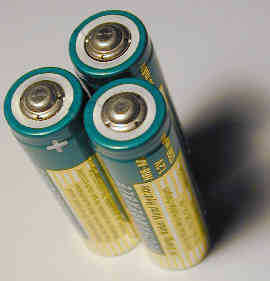Batteries
 Contrary to popular belief, a battery does not store energy but it is used to make electrical energy when needed.
Contrary to popular belief, a battery does not store energy but it is used to make electrical energy when needed.
Electrical energy is produced in a battery by the reactions of two electrodes. Each electrode is linked to one of the battery’s metal terminals. When the battery is linked into a circuit, there is a flow of electrons from one terminal (negative) through the circuit to the other terminal (positive). This is because the electrode starts to dissolve releasing electrons into the wire of the circuit at the negative terminal. The other electrode also loses electrons from one electrode through the circuit to make up the deficiency at the other electrode. In this way chemical energy is converted into electrical energy. Some batteries can be recharged by passing electrical energy through them. The electrical energy reverses the chemical reactions that produce the power.
Activity: A simple battery can be made by using a pile of ten 2p coins interspaced with blotting paper and foil. Cut our some round shapes of blotting paper and aluminium foil (a little larger than a 2p coin). Soak the blotting paper in salty water. Place a piece of foil over a 2p coin and a piece of salty blotting paper on top. Repeat these layers to make a small pile. Fix the end of a piece of wire underneath the pile and another on top. If the free ends of the wire are connected in a circuit with a light bulb, chemical reactions in the pile make electrical energy flow and the bulb lights up.
Read More: Saving Energy